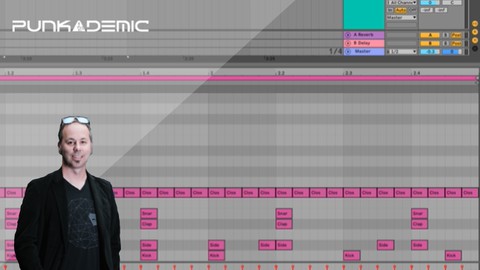Music Theory
Loại khoá học: Instruments
An in-depth and straight forward approach to understanding music.
Mô tả
Why should I learn music theory? Isn't it just "theoretical" knowledge that I won't really use? Nothing could be further from the truth! Music theory also has many practical applications. A musician who has studied music theory has a huge advantage over a musician who has not. Not only will they read music more fluently, their performances will be more musical because they will understand the various elements of music and how all the parts work together. Song writers and composers with a background in music theory will also have a huge advantage over those without such a background. In fact, for those who want to write music, there is nothing more important than having a firm understanding of music theory.
Why You Should Take This Course:
you will be learning from a professional musician and award-winning composer
the course is in-depth and covers all levels
the material is presented in a straight forward and easy to understand approach
the videos and PDFs get right to the point, and do not ramble on for lengthy amounts of time saying very little and leaving you confused
you will go beyond just definitions and terms and get the added benefit of learning the "why" behind the subject matter
Includes:
112 lectures
over 350 diagrams
over 90 audio examples
369 memory questions
45 on-line quizzes
nearly 1,000 quiz questions
exercises, experiments and downloadable music apps
Bạn sẽ học được gì
The definition of music
The elements of music (rhythm & pitch)
Division of pitch into melody and harmony
Rhythmic notation
Understanding relative durations of sound
The whole, half, quarter, 8th and 16th notes
Why notes are named the way they are
Relative durations vs. assigning numerical values
The unit of measurement
Beat
Tempo
Meter
Distinguishing between rhythm and meter
Bar lines and measures
Time signatures
2/4, 3/4 and 4/4 meters
Determining the meter without a time signature
Natural division of rhythms
Strong and weak pulses
Rests
Assigning numerical values to rests
The whole rest and meter
Dotted notes
Numerical values of dotted notes
History of dotted notes
Dotted rhythms
The 3:1 ratio in dotted rhythms
The tie
Ties vs. dotted notes
Advantages and disadvantages of notating with ties vs. dots
Re-designation of the unit
3/8 and 6/8 meters
New numerical values of notes
Understand relative durations with regard to a new unit of measurement
Strength of pulses
Designating the half note as the unit
Notating 2/2 meter or “cut” time
Numerical values of note durations in 2/2 meter
Comparison of 4/4 meter and 2/2 meter
Reasons for 2/2 meter
Classifying meters
Simple meter and compound meter
Duple, triple, and quadruple meter
Complex meter
Artificial divisions of the beat or beats
Artificial division of parts of the beat
Common types of tuplets
Definition of triplets & duplets
Identifying triplets & duplets
Ratio of triplets & duplets
Numerical value of triplets & duplets
Artificial divisions in relation to simple and compound meters
Sound waves
Frequency
Indefinite vs. definite pitch
Modern vs. ancient definition of pitch
Pitch experiments
Introduction to the staff
How the mind sees number
Ledger lines
Clefs
Movement on the staff (step, skip, repeat)
The musical alphabet
Letter names on the staff
The grand staff
Direction of note stems (and rationale)
Introduction to the keyboard
Groups of black keys
Letter names of keys
Correlation of staff to the keyboard
Half steps and whole steps
Sharps and flats on the keyboard
Enharmonic equivalents
Enharmonic keyboard notes
Reading sharps and flats on the staff
Sharps and flats within measures
The natural sign
The definition of interval
Melodic vs. harmonic intervals
Identifying intervals on the keyboard
Identifying intervals on the staff
Ratios and intervals
Pythagoras and the monochord
Consonance and dissonance
Definition and history of the modern scale
The major scale
Intervals and the major scale
Basis of the scale
Basis of the whole tone
Greek tetrachords
Greek semi tone and whole tone
Constructing scales on the keyboard
Constructing scales on the staff
Definition of "key"
The key signature
The circle of 5ths
The order of sharps
The order of flats
How to determine the key from the sharps/flats
How to determine how many and which sharps/flats are in a given key
Enharmonic keys
Interval number vs. interval quality
Major, minor and perfect interval qualities
Determining an intervals’ number and quality
Connection of interval qualities to the major scale
Identifying intervals on the staff
Augmented and diminished interval qualities
How augmented and diminished intervals are formed
The double sharp
Why the double sharp is necessary
The double flat
Why the double flat is necessary
The tritone
Abbreviations for interval qualities
Enharmonic intervals
Complementary intervals
Which qualities, when inverted, become which qualities
Simple intervals
Compound intervals
Reducing compound intervals
How to determine the quality of compound intervals
Open and close harmony
The difference between intervals and chords
Major and minor chords
Deriving the ratio of the major and minor 3rds using the monochord
The Pythagoras experiment and the major chord
Block and broken chords
Augmented and diminished chords
Music’s move from the horizontal to the vertical
Mathematical proportions of the major, minor, augmented and diminished triads
Understanding the harmonic mean
The harmonic mean and the major chord
Understanding the arithmetic mean
The arithmetic mean and the minor chord
The geometric mean and the augmented and diminished chords
Relation of chords to the major scale
The number of possible triads constructed from the pitches of the major scale
Order and quantity of triad qualities formed from the major scale
Roots of chords, scales, and keys
Comparison of the major and minor scales
Tetrachords in minor scales
The natural minor scale
Constructing natural minor scales on the keyboard & staff
The harmonic minor scale
The melodic minor scale
Ascending vs. descending melodic minor scale
Constructing harmonic minor scales on the keyboard & staff
Constructing melodic minor scales on the keyboard & staff
Relative keys
Determining the relative minor
Determining the relative major
Determining the key of music with shared key signatures
Parallel keys
Difference between parallel and relative keys
Relation of chords to the natural minor scale
Order and quantity of triad qualities formed from the natural minor scale
Relation of chords to the harmonic minor scale
Order and quantity of triad qualities formed from the harmonic minor scale
The major scale degrees
Naming the scale degree using Roman numerals
Naming triads using Roman numerals
Benefit to using degree vs. letter name
Primary chords and their importance
Relationship between chords
Chord inversions
Root position, 1st inversion and 2nd inversion
Intervals in chord inversions
The root rule
How to identify chord inversions by name, quality and inversion
Voices of a chord
Voice leading
Inversions and the primary chords
Chord progressions
Use of inversions to improve transition between chords
Introduction to function
Function names of the scale degrees
Extending the triad
Dominant seventh chords
Other names and notation of the dominant seventh chord
Why the dominant seventh chord is named the way it is
Inversion of the dominant seventh chord
3rd inversion
Finding the root in a dominant seventh chord
How to identify a dominant seventh chord
Dominant seventh chords with missing notes
Major 7th chords
Minor 7th chords
Diminished 7th chords
Musical punctuation
Perfect authentic cadence
Imperfect authentic cadence
Half cadence
Plagal cadence
Deceptive cadence
Hexatonic scale
Whole tone scale
Chromatic scale
Pentatonic scale
Tonal music
Tonal centers
Polytonal music
Atonal music
Free atonal
Strict atonal
Twelve-tone technique
Tone rows
The ancient Greek modes
History of the church modes
Modern modes
The harmonic series
Overtones
Fundamental of a pitch
Complex vibration of a string
What the numbers of the harmonic series express
Hearing overtones (and experiment)
Timbre
Nature’s hierarchy of harmonic sound
Objective measurement of consonance and dissonance
History of consonance and dissonance
Tuning pitches
Brief history of tuning systems
Pythagorean tuning
Just intonation
Equal temperament
Definition of cents
Tuning of the modern piano
Benefits and shortcomings of the different tuning systems
Apps that demonstrate and compare some of the tuning systems
Overview of the four main periods of western art music
Yêu cầu
- no previous musical knowledge is needed
Nội dung khoá học
Viết Bình Luận
Khoá học liên quan

Đăng ký get khoá học Udemy - Unica - Gitiho giá chỉ 50k!
Get khoá học giá rẻ ngay trước khi bị fix.


















Đánh giá của học viên
Bình luận khách hàng